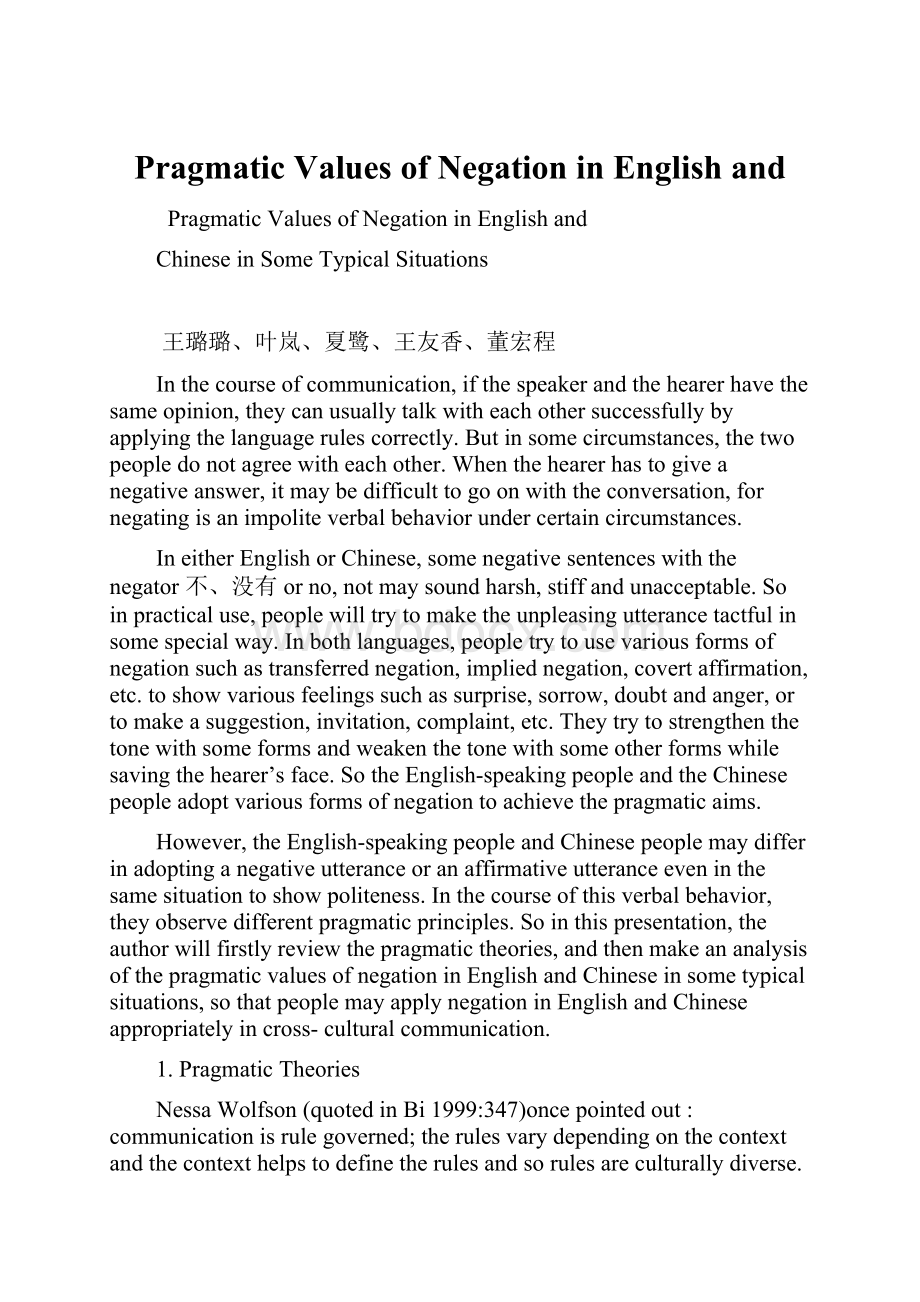Pragmatic Values of Negation in English and.docx
《Pragmatic Values of Negation in English and.docx》由会员分享,可在线阅读,更多相关《Pragmatic Values of Negation in English and.docx(10页珍藏版)》请在冰豆网上搜索。

PragmaticValuesofNegationinEnglishand
PragmaticValuesofNegationinEnglishand
ChineseinSomeTypicalSituations
王璐璐、叶岚、夏鹭、王友香、董宏程
Inthecourseofcommunication,ifthespeakerandthehearerhavethesameopinion,theycanusuallytalkwitheachothersuccessfullybyapplyingthelanguagerulescorrectly.Butinsomecircumstances,thetwopeopledonotagreewitheachother.Whenthehearerhastogiveanegativeanswer,itmaybedifficulttogoonwiththeconversation,fornegatingisanimpoliteverbalbehaviorundercertaincircumstances.
IneitherEnglishorChinese,somenegativesentenceswiththenegator不、没有orno,notmaysoundharsh,stiffandunacceptable.Soinpracticaluse,peoplewilltrytomaketheunpleasingutterancetactfulinsomespecialway.Inbothlanguages,peopletrytousevariousformsofnegationsuchastransferrednegation,impliednegation,covertaffirmation,etc.toshowvariousfeelingssuchassurprise,sorrow,doubtandanger,ortomakeasuggestion,invitation,complaint,etc.Theytrytostrengthenthetonewithsomeformsandweakenthetonewithsomeotherformswhilesavingthehearer’sface.SotheEnglish-speakingpeopleandtheChinesepeopleadoptvariousformsofnegationtoachievethepragmaticaims.
However,theEnglish-speakingpeopleandChinesepeoplemaydifferinadoptinganegativeutteranceoranaffirmativeutteranceeveninthesamesituationtoshowpoliteness.Inthecourseofthisverbalbehavior,theyobservedifferentpragmaticprinciples.Sointhispresentation,theauthorwillfirstlyreviewthepragmatictheories,andthenmakeananalysisofthepragmaticvaluesofnegationinEnglishandChineseinsometypicalsituations,sothatpeoplemayapplynegationinEnglishandChineseappropriatelyincross-culturalcommunication.
1.PragmaticTheories
NessaWolfson(quotedinBi1999:
347)oncepointedout:
communicationisrulegoverned;therulesvarydependingonthecontextandthecontexthelpstodefinetherulesandsorulesareculturallydiverse.Socommunicationrulesarebothculturallyandcontextuallybound.Whatismostdifficultininterculturalcommunicationisthatcommunicationrulesarenotonlyculturespecificbutalsolargelyunconscious.Whatisworseisthatpeoplemaytransfertherulesoftheirownculturetotheinterculturalcontext,whichmaycausemisunderstandingsonbothsides(Samovar1991).Thisjustifieswhywewillhaveareviewofthefollowingimportantpragmatictheories.
1.1Grice’sCooperativePrinciple
H.P.Grice(1975)maintainsthatthereisasetofover-archingassumptionsguidingtheconductofconversation.Heidentifiesfourbasicmaximsofconversationunderlyingtheefficientcooperativeuseoflanguage,whichjointlyexpressesageneralcooperativeprinciple.TheCooperativePrinciple(CP)isexpressedasfollows:
1.TheMaximofQuality:
Trytomakeyourcontributiononethatistrue,specifically:
(a)donotsaywhatyoubelievetobefalse;
(b)donotsaythatforwhichyoulackadequateevidence
2.TheMaximofQuantity:
(a)makeyourcontributionasinformativeasisrequiredforthecurrentpurposesoftheexchange;
(b)donotmakeyourcontributionmoreinformativethanisrequired
3.TheMaximofRelevance:
makeyourcontributionrelevant
4.TheMaximofManner;
(a)avoidobscurity:
(b)avoidambiguity;
(c)bebrief;(d)beorderly(Levinson1983:
101-102)
Thesemaximsspecifywhatparticipantshavetodoinordertoconverseinanefficient,rational,andcooperativeway.Theyshouldspeaksincerely,relevantlyandclearly,whileprovidingsufficientinformation.Butinfact,peopledonotalwaysfollowthesemaxims.Sometimesthemaximsareevenblatantlyviolated.Forexample,theEnglish-speakingpeopletendtosay,“Idon’tthinkheishonest”tomean,“Ithinkheisnothonest”.InEnglish,suchtransferringis10to1insentenceswiththink,suppose,etc.(Quirk&Svartik1980).Inthisverbalbehavior,peopleobviouslyviolatetheMaximofQualityinCP.Theymustobserveotherpragmaticprinciples.
1.2BrownandLevinson’sFaceTheory
Withintheireverydaysocialinteractions,peoplegenerallybehaveasiftheirexpectationsconcerningtheirpublicself-image,ortheirfacewantswillberespected.BrownandLevinson(1978)analyzepolitenessasshowingawarenessoftheneedtopreserveface(publicself-image).ThegeneralideaofBrownandLevinson’smodelofpolitenessistounderstandvariousstrategiesforinteractionalbehaviortoachievesatisfactionofcertainwants.Thewantsrelatedtopolitenessarethewantsofface,“somethingthatisemotionallyinvested,andthatcanbelost,maintained,andenhanced,andmustbeconstantlyattendedtoininteraction”(BrownandLevinson1978:
66).Theconceptisdirectlyrelatedtothefolk-expression“loseface”,whichisaboutbeingembarrassedorhumiliated.Ifaspeakersayssomethingthatrepresentsathreattoanotherindividual’sexpectations,itisdescribedasaFaceThreateningAct.And,giventhepossibilitiesthatsomeactionmightbeinterpretedasathreattoanother’sface,thespeakercansaysomethingtolessenthepossiblethreat.ThisiscalledaFaceSavingAct.Generallyspeaking,eachparticipantinvolvedininteractionswillattempttorespectthefacewantsofothersandtherearedifferentwaysofperformingfacesavingacts.
AccordingtoBrownandLevinson(1978),therearetwoaspectsofface.Oneis“positiveface”,thepositiveconsistentself-imagethatpeoplehaveandwanttobeappreciatedandapprovedofbyatleastsomeotherpeople.Theotheris“negativeface”,ortherighttoterritories,freedomofactionandfreedomfromimposition;essentiallythewantthatone’sactionsarenotimpededbyothers.So,afacesavingactwhichisorientedtotheperson’snegativefacewilltendtoshowdeference,emphasizetheimportanceoftheother’stimeorconcerns,andevenincludeanapologyfortheimpositionorinterruption.Thisisalsocallednegativepoliteness.Afacesavingactwhichisconcernedwiththeperson’spositivefacewilltendtoshowsolidarity,emphasizethatbothspeakerswantthesamething,andthattheyhaveacommongoal.Thisiscalledpositivepoliteness(Yule2000:
61-62).
Actually,theCooperativePrincipleandFaceTheorycannotsatisfactorilyexplainsomeapparentexpectations.Basedontheformer,LeechproposestheconceptofthePolitenessPrinciple(PP).
1.3Leech’sPolitenessPrinciple
Leech’sviewofpolitenessinvolvesasetofpolitenessmaxims.Amongtheseare:
1.TactMaxim
(a)minimizecosttoother;(b)maximizebenefittoother
2.GenerosityMaxim
(a)minimizebenefittoself;(b)maximizecostofself
3.ApprobationMaxim
(a)minimizedispraiseofother;(b)maximizepraiseofother
4.ModestyMaxim
(a)minimizepraiseofself;(b)maximizedispraiseofself
5.AgreementMaxim
(a)minimizedisagreementbetweenselfandother;(b)maximizeagreementbetweenselfandother
6.SympathyMaxim
(a)minimizeantipathybetweenselfandother;(b)maximizeagreementbetweenselfandother(Leech1983:
132)
LeecharguesthattheCooperativePrincipleisnotsufficienttoexplaintheindirectnessinconversationandbothCPandPParerequiredtoaccountforinterpretationofindirectnessintheauthenticcommunication.SoPolitenessPrinciplecanberegardednotjustasanotherprincipletobeaddedtotheCooperativePrinciple,butasanecessarycomplement,whichrescuestheCooperativePrinciplefromserioustrouble.TheCooperativePrinciplecanhelpustoregulatewhatwesaysothatitcontributestosomeassumedillocutionaryordiscoursegoals.However,thePolitenessPrinciplehasahigherregulativerolethanthis,tomaintainthesocialequilibriumandfriendlyrelations,whichenableustoassumethatourinterlocutorsarebeingcooperativeinthefirstplace.
“Modesty”isemphasizedinEnglishculture,anditisevenmoreimportantinChineseculture.ThecoreofChinesepolitenessisshownbydenigratingselfandrespectingother.However,theculturalconnotationsofChinesemodestyaredifferentfromthatofLeech’s“modesty”inhis“ModestyMaxim”:
ChinesemodestyistoputdownselfandtobuildupotherwhereasLeech’s“ModestyMaxim”isavoidingself-praise;ChinesemodestyisacoreofChinesepolitenesswhereasthe“ModestyMaxim”isnotmoreimportantthantheothermaximsofLeech’sPolitenessPrinciple;Chinesemodestyisavirtueofself-cultivationthatisthefoundationonwhichpolitenessisbuiltwhereasEnglishmodestyisastrategyofminimizingpraiseofself.SoChinesepolitenesshasitsowncharacteristics.Basedonthis,顾曰国(1990and1994)proposedtheChinesepolitenesstheory(CPT).
1.4GuYueguo’sChinesePolitenessTheory
Chinaisacountryfamousforheruniquemodesty—self-depreciationforshowingrespecttoother.GuYueguo(1990)pointsoutthefouroutstandingcharacteristicsofChinesepoliteness,theyare:
respectforother(respectfulness),denigrationofself(modesty),warmthtowardsother(attitudinalwarmth)andrefinementinlanguageuse.Respectforotherisself’spositiveappreciationoradmirationofotherconcerningthelatter’sface,socialstatus,andsoon.Denigrationofselfisself’swayofshowingmodesty.Warmthtowardotherisself’sdemonstrationofkindness,consideration,andhospitalitytoother.Refinementinlanguageusereferstoself’sbehaviortootherwhichmeetcertainstandards(Gu1990:
239).FollowingLeech’sframework,Gu(1994:
496-511)hasformulatedfivepolitenessmaxims.
1.Self-depreciationMaxim
(a)depreciateself;(b)raiseother
2.AddressingMaxim
addressotherproperlyaccordingtohisorhersocialrank,economicstatusandage
3.RefinementMaxim
(a)berefinedinspeech;(b)avoidobs